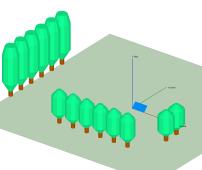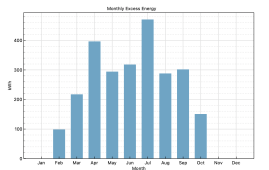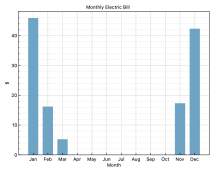hamburgerman
New Member
- Joined
- Aug 9, 2021
- Messages
- 28
After going through many designs, I think I've finally settled on my final parts list! I've got some parts on order and am still finalizing some minor details, but hope to start installing everything in the next few months!
Goals
We're in Michigan, with DTE as our provider, and our distributed generation program is not a good one, thanks to the amount credited and how they calculate the net. So, even with full grid tie and power export, I could never justify this on pure economics. While money is absolutely a factor, that's not all I care about. The main goals for this project are as follows:
Trying to check all these boxes was very challenging. The Sol-Ark 12k was the closest I could get, but the limited AC passthrough when on grid meant that we'd risk tripping something if we had too much running at once. Thankfully, the Sol-Ark 15 solves that problem, by offering full 200A passthrough, so I can finally meet all my goals!
Parts List / System Design
I'll be doing a grid tied, but 0 export system. This does translate to wasted power that we are not selling; however, it also means I don't have to do the interconnect paperwork and all the associated red tape, which also translates to savings in labor since I can DIY much more of this. This will also be a ground mount system, since I don't want to punch holes in my roof, and it's not well aligned for solar even if I did.
Modeling And System Planning
I have been running tons of simulations with SAM. If you haven't seen it before, it's pretty awesome. With that software, I was able to run simulations that factor in all of the following:

Estimated Results
So, not a great payback, and that's a lot of wasted power that I'm not exporting ~$405 worth at full retail rates, in fact. However, as I mentioned, the billing with DTE is such that we'd not see anywhere near that in reality - it would be maybe $200 / year if we were really lucky, and that is before considering the ideas being floated around about adding monthly surcharges to solar customers.
Furthermore, this does not account for the fact that we plan to utilize as much of that otherwise wasted power as possible for EV charging. With our driving style and flexible schedules, we should be able to keep at least one vehicle charged for much of the year, which is more than the value we'd get selling the power back - even considering we're still wasting a lot of this power.

Our bill for the house (ignoring the meter fee / mandatory monthly min) will basically be 0 for half of the year:

Of course, these are just estimates, and anything can happen - but I'm happy with the plan. It achieves all the goals I set out, while still being technically a positive investment (we'll just ignore opportunity cost here, right? ).
).
Goals
We're in Michigan, with DTE as our provider, and our distributed generation program is not a good one, thanks to the amount credited and how they calculate the net. So, even with full grid tie and power export, I could never justify this on pure economics. While money is absolutely a factor, that's not all I care about. The main goals for this project are as follows:
- Offset as much of the power use of our main house meter as reasonable
- Provide power during a grid outage
- We do have a 22kw standby generator, so this system needs to play nice with that
- I also wanted the system large enough to continue running most of the house if the generator failed
- Battery must have sufficient capacity and power available
- Support "smart" EV charging, as a way to utilize otherwise wasted overproduction
- Offer UPS protection to the house, so grid outages (and the pause between firing up the generator and ATS tripping) would be transparent
- Allow us to comfortably power all our main home circuits when on grid (we are an all electric house, though the HVAC is on another meter/panel)
- In a REAL shit scenario, I want to be able to swap some wires around so this system can power my HVAC (a ground source heat pump). Thus, it has to be sized enough to meet the power requirements for that (and only that, I'd only do one panel or the other at any given time)
Trying to check all these boxes was very challenging. The Sol-Ark 12k was the closest I could get, but the limited AC passthrough when on grid meant that we'd risk tripping something if we had too much running at once. Thankfully, the Sol-Ark 15 solves that problem, by offering full 200A passthrough, so I can finally meet all my goals!
Parts List / System Design
I'll be doing a grid tied, but 0 export system. This does translate to wasted power that we are not selling; however, it also means I don't have to do the interconnect paperwork and all the associated red tape, which also translates to savings in labor since I can DIY much more of this. This will also be a ground mount system, since I don't want to punch holes in my roof, and it's not well aligned for solar even if I did.
| Part | QTY | |
| Panel | Q.Peak Duo BLK ML-G10+ 400 | 14 |
| Inverter | Sol-Ark 15k | 1 |
| Battery | 100Ah 48v Server Rack Battery | 2 |
Modeling And System Planning
I have been running tons of simulations with SAM. If you haven't seen it before, it's pretty awesome. With that software, I was able to run simulations that factor in all of the following:
- The last year of hourly usage data from DTE as the load calculation (I can export it from my account)
- The exact inverter / cells being used
- Shading effects, using the included 3D modeling
- Weather, based on your location data
- Financial impact, based on imported utility rates
- System losses / inefficiency / degradation
- Array tilt/azimuth/string configuration
- So much more!

Estimated Results
| Payback Period | 21.8 Years |
| Annual Savings (1st Year) | $757 |
| Annual Excess (Wasted) Generation | 2534 kWh |
So, not a great payback, and that's a lot of wasted power that I'm not exporting ~$405 worth at full retail rates, in fact. However, as I mentioned, the billing with DTE is such that we'd not see anywhere near that in reality - it would be maybe $200 / year if we were really lucky, and that is before considering the ideas being floated around about adding monthly surcharges to solar customers.
Furthermore, this does not account for the fact that we plan to utilize as much of that otherwise wasted power as possible for EV charging. With our driving style and flexible schedules, we should be able to keep at least one vehicle charged for much of the year, which is more than the value we'd get selling the power back - even considering we're still wasting a lot of this power.

Our bill for the house (ignoring the meter fee / mandatory monthly min) will basically be 0 for half of the year:

Of course, these are just estimates, and anything can happen - but I'm happy with the plan. It achieves all the goals I set out, while still being technically a positive investment (we'll just ignore opportunity cost here, right?


